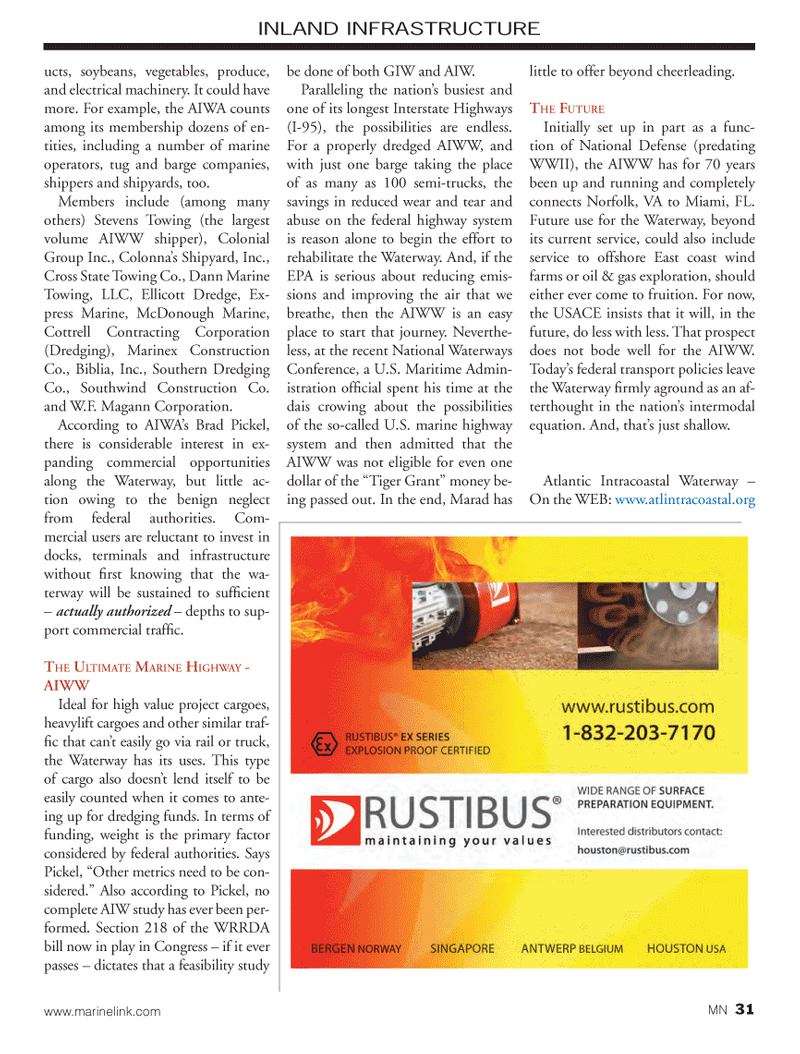
Page 31: of Marine News Magazine (November 2013)
Fleet Optimization Roundtable
Read this page in Pdf, Flash or Html5 edition of November 2013 Marine News Magazine
ucts, soybeans, vegetables, produce, and electrical machinery. It could have more. For example, the AIWA counts among its membership dozens of en- tities, including a number of marine operators, tug and barge companies, shippers and shipyards, too. Members include (among many others) Stevens Towing (the largest volume AIWW shipper), Colonial Group Inc., Colonna?s Shipyard, Inc., Cross State Towing Co., Dann Marine Towing, LLC, Ellicott Dredge, Ex- press Marine, McDonough Marine, Cottrell Contracting Corporation (Dredging), Marinex Construction Co., Biblia, Inc., Southern Dredging Co., Southwind Construction Co. and W.F. Magann Corporation. According to AIWA?s Brad Pickel, there is considerable interest in ex- panding commercial opportunities along the Waterway, but little ac- tion owing to the benign neglect from federal authorities. Com- mercial users are reluctant to invest in docks, terminals and infrastructure without rst knowing that the wa- terway will be sustained to suf cient ? actually authorized ? depths to sup-port commercial traf c.THE ULTIMATE MARINE HIGHWAY - AIWWIdeal for high value project cargoes, heavylift cargoes and other similar traf- c that can?t easily go via rail or truck, the Waterway has its uses. This type of cargo also doesn?t lend itself to be easily counted when it comes to ante-ing up for dredging funds. In terms of funding, weight is the primary factor considered by federal authorities. Says Pickel, ?Other metrics need to be con- sidered.? Also according to Pickel, no complete AIW study has ever been per- formed. Section 218 of the WRRDA bill now in play in Congress ? if it ever passes ? dictates that a feasibility study be done of both GIW and AIW. Paralleling the nation?s busiest and one of its longest Interstate Highways (I-95), the possibilities are endless. For a properly dredged AIWW, and with just one barge taking the place of as many as 100 semi-trucks, the savings in reduced wear and tear and abuse on the federal highway system is reason alone to begin the effort to rehabilitate the Waterway. And, if the EPA is serious about reducing emis- sions and improving the air that we breathe, then the AIWW is an easy place to start that journey. Neverthe- less, at the recent National Waterways Conference, a U.S. Maritime Admin- istration of cial spent his time at the dais crowing about the possibilities of the so-called U.S. marine highway system and then admitted that the AIWW was not eligible for even one dollar of the ?Tiger Grant? money be- ing passed out. In the end, Marad has little to offer beyond cheerleading. THE FUTUREInitially set up in part as a func- tion of National Defense (predating WWII), the AIWW has for 70 years been up and running and completely connects Norfolk, VA to Miami, FL. Future use for the Waterway, beyond its current service, could also include service to offshore East coast wind farms or oil & gas exploration, should either ever come to fruition. For now, the USACE insists that it will, in the future, do less with less. That prospect does not bode well for the AIWW. Today?s federal transport policies leave the Waterway rmly aground as an af- terthought in the nation?s intermodal equation. And, that?s just shallow. Atlantic Intracoastal Waterway ? On the WEB: www.atlintracoastal.org INLAND INFRASTRUCTUREwww.marinelink.com MN 31MN November2013 Layout 18-31.indd 31MN November2013 Layout 18-31.indd 3110/28/2013 3:15:35 PM10/28/2013 3:15:35 PM

 30
30

 32
32
